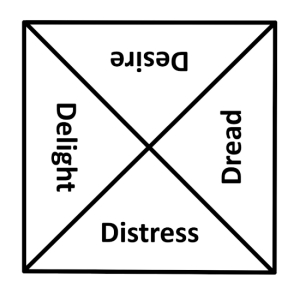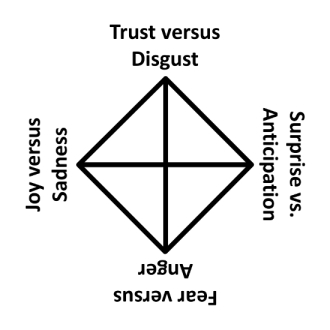 Emotions are also often divided into sixteen different types instead of the eight we saw in The Circumplex Model of Affect. The Geneva Emotion Wheel (1.0) used the same Valence and Arousal axes and produced the following 16 emotions:
Emotions are also often divided into sixteen different types instead of the eight we saw in The Circumplex Model of Affect. The Geneva Emotion Wheel (1.0) used the same Valence and Arousal axes and produced the following 16 emotions:
(Circular Order) Anger, Contempt, Disgust, Envy, Guilt, Shame, Fear, Sadness, Surprise, Interest, Hope, Relief, Satisfaction, Joy, Elation, Pride
(Alphabetized) Anger, Contempt, Disgust, Elation, Envy, Fear, Guilt, Hope, Interest, Joy, Pride, Relief, Sadness, Satisfaction, Shame, Surprise
(But an updated GEW Version 3.0 has 20 emotions in a circle on Valence and Control axes. See below for details.)
Another study used a Deep Neural Network on a training set of emotional facial expressions. They used the algorithm to track instances of 16 facial expressions one tends to associate with amusement, anger, awe, concentration, confusion, contempt, contentment, desire, disappointment, doubt, elation, interest, pain, sadness, surprise and triumph. (See below for details.)
Further Reading:
Deep Neural Network Study:
GEW (Geneva Emotion Wheel, Version 1.0)
https://www.researchgate.net/publication/280880848_Geneva_Emotion_Wheel_Rating_Study
GEW Version 3.0, with 20 emotions on a Valence and Control wheel with 2 options per emotion (in Circular Order):
Irritation, Anger
Contempt, Scorn
Disgust, Repulsion
Envy, Jealousy
Disappointment, Regret
Guilt, Remorse
Embarrassment, Shame
Worry, Fear
Sadness, Despair
Pity, Compassion
Longing, Nostalgia
Astonishment, Surprise
Feeling Disburdened, Relief
Wonderment, Feeling Awe
Tenderness, Feeling Love
Enjoyment, Pleasure
Happiness, Joy
Pride, Elation
Amusement, Laughter
Involvement, Interest
https://www.frontiersin.org/articles/10.3389/fpsyg.2021.662610/full
There are also several Classroom Charts available for Teachers and Students, for example (both in Alphabetical order):
Angry, Bored, Confused, Curious, Disappointed, Embarrassed, Excited, Grumpy, Happy, Nervous, Proud, Sad, Scared, Shy, Silly, Surprised
Angry, Afraid, Bored, Embarrassed, Excited, Guilty, Happy, Hopeful, Loved, Jealous, Proud, Sad, Shy, Sorry, Surprised, Tired
Images for Sixteen Emotions:
https://www.google.com/search?q=16+emotions&client=firefox-b-1-d&hl=en&tbm=isch
<>









